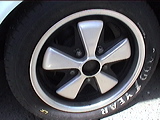Posted on 12/26/2010

Since the introduction of the modern steel belted radial tire, automotive tires can now safely last upwards to 80,000 miles. Most automotive manufacturers recommend that tires be in service no longer than 6 years on the vehicle, and no longer than 10 years from the date of manufacture. DOT Number — Mandated by the federal government, every tire has a Department of Transportation number. Up until 1999, the last 3 digits (and from 2000 on, the last 4 digits) of the DOT number describes the week and year the tire was manufactured. For example, tires manufactured in 1999 and earlier with a DOT number ending in 299 would mean the tire was manufactured in the 29th week of 1989 or 1999. From 2000 on, a tire manufactured in the 29th week of 2009 would have 2909. In all actuality, the amount of rubber that touches the road, also known as the contact patch, is only approximately a 3” x 8” rectangular section. Contrary to popular belief ... read more
Posted on 12/26/2010
Water intrusion is one of the few unnoticed killers of the modern automobile. All modern Porsches are even more sensitive to water damage because of their many delicate electrical control units and computers. I remember this all started years ago when Porsche issued a service bulletin on the 924 to re-route and seal the antenna cable because water could travel along this cable and find its way into the central electrics panel inside the vehicle and create havoc with the electrical system. The main area to watch for water collection in the 986 thru 997’s is the front cowl area. The front cowl area is located just below the base of the windscreen and has water drains on both sides of the battery. There are two front cowl area cavities where debris such as leaves and dirt can collect and in time clog the front cowl drains. When these drains clog water will accumulate in these cavities and at a point migrate into the interior compartment of the vehicle. Water ... read more
Posted on 12/25/2010
This month we cover issues relating to the lead acid battery and what to do when you have trouble with one. Last month we looked at the components in the electrical system and how they interact. A typical battery problem scenario: you’ve been driving for a half hour or so (your Porsche is running great), you stop at a store for about 15 minutes, return to your car, insert and turn the key to start the engine and hear a rapid clicking noise (sometimes you will not hear anything). The engine is not turning over, so you try it again — nothing. You may have headlights and instrument lights and everything appears to be OK, but your car will not start. The old adage of if the headlights come on doesn’t apply any longer. The battery may have enough voltage to run various items, but not the starter. Your car has a dead battery, so what do you do now? We will get back to that, but first some background. Usually a battery will just die from old age. It can ... read more